When you hear the words “power transmission,” what do you think of? Most people think of automobiles. But mechanical power transmission is much more than that– in fact, it’s everywhere you look.
What is Power Transmission?
At its core, power transmission is simply the movement of energy from one place to the next. That energy begins with a power source. The energy from that power source moves through components to accomplish some kind of work. A great, simplified example of this is the movement of a bicycle.
When you pedal a bicycle, you use your legs (the power source) to apply force to the pedals. That force moves through components on the bike to power the wheel and moves the bike forward (the work).
First, the power you’ve applied pushes the crank arms that attach to the pedals. Those crank arms connect to the sprocket (the ring the bike chain loops around). When the sprocket moves, it pulls along the chain that is engaged with it.
That chain is on a loop, and wraps around the sprocket behind you, that sits in the middle of the rear wheel. The force you’ve applied to the chain, through the first sprocket, now rotates this rear sprocket. The rear sprocket then rotates the back wheel, as you steer with the now also-rotating front wheel. And you’re off, putting rubber to the road!
This is just one example of mechanical power transmission. We’ll go through the common components of power transmission for all kinds of industrial motion, and provide product examples in this article.
Key Components of Power Transmission Systems
Chains and Sprockets
Chains and sprockets are a common way to transmit power. As we discussed above in the bicycle example, chains engage with sprockets. They do so very effectively, making them a great choice for precise, durable power transmission.
This is because the chain and sprockets work so well together. The chain is made up of connected lengths that precisely engage with the teeth of the sprocket, similar to puzzle pieces coming together. As a driver sprocket rotates, it pulls the chain along, transferring that power to the driven sprocket.
In the bicycle example, the drive sprocket is attached to the crank arms that are connected to the pedals. The force applied from your legs to the pedals rotates the drive sprocket, pulling the chain, and in turn rotating the driven sprocket in the back wheel. This same movement is replicated in all kinds of components (for example, motors) that use chains and sprockets for power transmission.

There are many different kinds of chains. The most common type is roller chain, which is a series of cylindrical rollers held together by side plates that adjoins using pins and/or bushings. You will see them on anything from a child’s bike to massive pieces of industrial machinery.
Leaf chains are used in lifting applications, such as forklifts and hoists. Leaf chains use interlaced plates that are connected by pins, which gives them high tensile strength. There are also “silent” chains, which have teeth that more precisely mesh with the sprocket, reducing noise and providing smoother operation.
Sprockets come in a variety of styles as well, all designed specifically to interact with these different types of chains. Industry specification standards like ANSI and ISO help make these pairings seamless.
It is important to note that sprockets are actually quite different than gears, despite looking similar. A sprocket always engages with a chain or belt. A gear transmits power by interlocking with each other, which we will discuss next.
Gears
Gears are essential components for transmitting force, and also altering the speed and direction of rotation. They’re most easily identified by their interlocking teeth. These teeth, through constant engagement with each other, transmit motion from one gear to the other by creating a turning force, also known as torque.
While bicycles use sprockets instead of gears, the concept of transmission of power is still the same. Instead of the driving force coming from someone pedaling, it may be coming from a motor as a power source, which will power the gears that rotate against each other.


Helical gears have teeth that are cut at an angle to the gear axis. This allows for more gradual engagement of the teeth, which can result in smoother and quieter operation than spur gears. Because of this, they’re often used in automotive transmissions.
Bevel gears are conical in shape, and used to transmit motion between intersecting shafts. These are essential in differential drives, as they allow the wheels of a vehicle to rotate at different speeds while turning.


Worm gears operate differently, with a screw (the “worm”), which engages with a gear (the “worm wheel”). Worm gears are unique because they only operate in one direction– they are self-locking, so the worm can turn the gear, but the gear cannot turn the worm. This is a very useful feature in applications that need precise control that won’t “roll back,” such as lifts/elevators and conveyors.
Shafts and Bearings
Shafts and bearings work together to accomplish the goal of power transmission. Shafts are cylindrical components that transmit rotational force. The movement of the shaft transmits the power from the motor itself to the machinery. So, for example, a shaft in the middle of a pulley– which we will discuss in the next section– provides the force that turns the pulley.
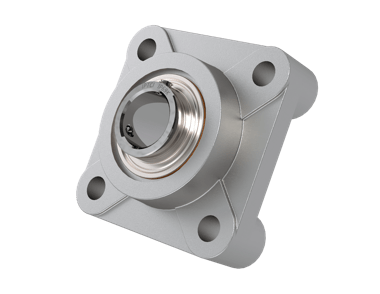

However, shafts need bearings. Bearings support the shaft, allowing it to rotate smoothly with minimal friction. Bearings are critical elements to reduce wear and tear on the shaft and housing, protecting the equipment and increasing efficiency.
There are a wide variety of bearings to choose from, including ball bearings (which use spherical balls that roll between an inner and outer ring), roller bearings (which use cylindrical, tapered or spherical rollers instead of balls), and needle bearings (which use long, thin rollers and have a high load capacity). These internal components help distribute the magnitude of the force evenly and minimize friction.


Solve IMG offers a wide range of options for bearings, from heavy to light duty applications. If you’re looking for hygienic food grade bearings, Solve IMG’s IPTCI products offer a wide variety of material combinations, with housing and inserts that address the unique demands of challenging wash-down, high-temperature conditions. The IPTCI IP69K lube-for-life design is a standout that can provide long life in extreme conditions.
Another Solve IMG Brand, PTI, offers their SRE unitized spherical roller bearings, as well as SAF spherical roller bearing mounted units. These reliable bearings are useful for a variety of heavy-duty applications. PTI has been serving high-performance industries for more than 50 years, known for their high-quality metric and American standard industrial-grade bearings and power transmission components.
Belts and Pulleys
Belts and pulleys (also referred to as sheaves) are known for their flexibility and efficiency in transferring power over longer distances. They work by creating friction between the belt and the pulley. Generally speaking, a belt is a looped flexible material that links two or more rotating shafts together.
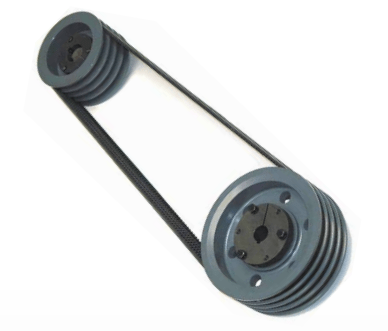

Those rotating shafts typically live in the center of pulleys. Pulleys are wheels with grooved rims around its edge (the circumference), which acts as a grip for the belt that loops around it.
The pulley is mounted to a shaft that is connected to another power source, such as a motor, which rotates the shaft. That shaft rotates the pulley, and in turn transmits the power to the element moving over it– like a belt.
This is again the same concept of power transmission we see in a bicycle. In this case, the power is the motor instead of legs on pedals– and a belt is being pulled by pulleys, instead of a chain being moved by sprockets.
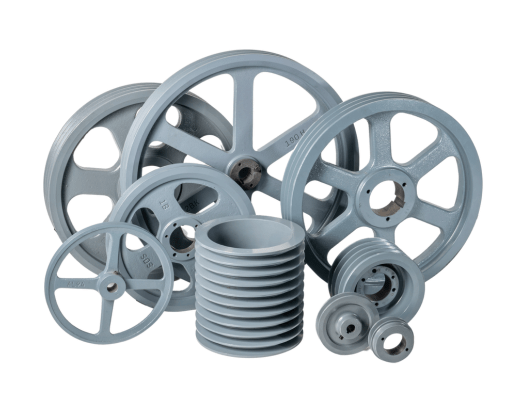

Meeting or exceeding ASTM/SAE specs for gray iron casting, they are statically balanced, furnished with standard keyways and set screws, and phosphorated to prevent rust.
Couplings and Bushings
Couplings take us even further inside your power source, to the connection of two shafts. Couplings connect two shafts together, allowing smooth transfer of power, and certain types can accommodate limited amounts of misalignment. For example, a motor may drive a shaft that is connected to another shaftusing a coupling that mechanically links these two shafts together.
A rigid coupling provides a solid connection and does not allow for any misalignment. A flexible coupling accommodates a slight degree of misalignment and provides a buffer against shock and vibrations. You will commonly see flexible couplings in compressors and pumps.
Fluid couplings use hydraulic fluid to transmit power, providing a smooth, controlled start. They are most often used when gradual acceleration and deceleration is common, like conveyor and fan systems.
Bushings live within couplings, sheaves, and sprockets. They are cylindrical linings that allow these components to be mounted on the shaft. They typically have a tapered outer surface that aligns with an opposing taper, which compresses on the shaft. This protects shafts from wear and helps to counteract slight misalignments. Solve IMG’s Masterdrive QD bushings are a popular, reliable choice.
Additionally, Masterdrive’s jaw couplings are a great example of a flexible coupling. Jaw couplings consist of two metal hubs with a shock-absorbing elastomeric spider between them. They require no lubrication and provide high reliability for most light to medium duty applications.
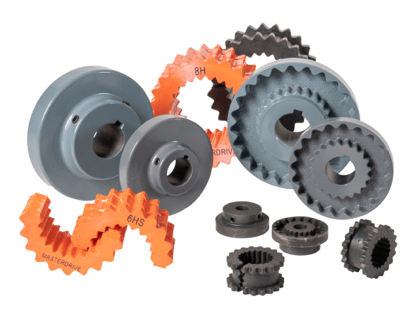

Different inserts are available depending on your application needs, including Buna nitrile, urethane, hytrel and bronze inserts. In normal operating conditions, these jaw couplings have no metal to metal contact, so the life of the hubs is virtually indefinite!
MD Flex couplings are also available, with inserts available in EPDM, neoprene, and hytrel, in both solid and split designs. Installation is simple, and no lubrication or maintenance is required.
Mechanical Power Transmission is Everywhere!
In summary, whether it’s on a bicycle, or within a motor, mechanical power is being transmitted all the time, everywhere you look. Mechanical power transmission is the literal driving force behind everything you see in motion.
Whether that power is being transferred from your legs to the pike pedals, or from a motor powering a shaft that’s rotating a 10 foot diameter pulley in your facility, the concept is the same!
Still Have Power Transmission Questions?
Even when you know the basics about mechanical power transmission, you might still have questions. And we’re here to help! It’s in the name– Industrial Bearing and Transmission. Reach out to our experts with questions big and small– we’re happy to help.
Looking for more in-depth training? We can help you with that too! We offer a specialized, two-and-a-half day, in-person training class that will bring you and your team up to speed. Learn more about all the in-person classes we offer here. You can also access over 900 courses for free in our Power Transmission Academy!
We look forward to finding the perfect power transmission solution for you and your facility.
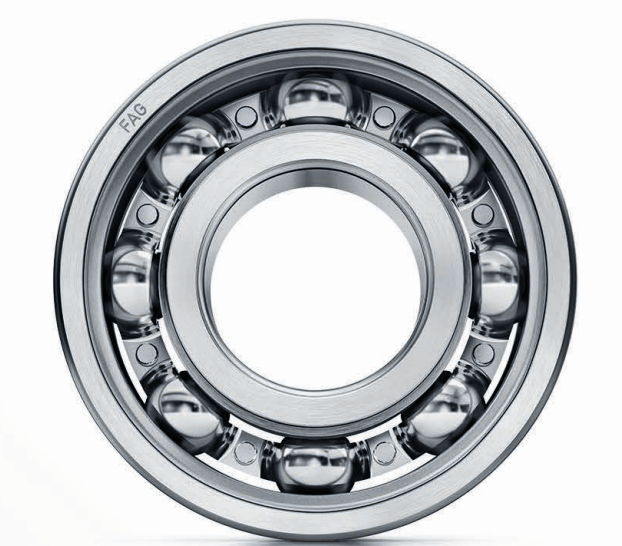

Explore All of Our Power Transmission Products on Shop IBT
Bearings, Belts, Motors and More!





